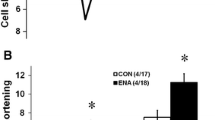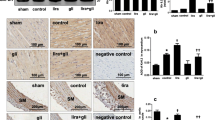Abstract
Telmisartan is an angiotensin II receptor blocker and partial peroxisome proliferator-activated receptor gamma agonist that modulates the renin–angiotensin–aldosterone system. It is used primarily to manage hypertension, diabetic nephropathy, and congestive heart failure. Recent studies have reported that myocardial infarction (MI) has occurred in telmisartan-treated patients. The purpose of the study was to investigate the specific conditions and underlying mechanisms that may result in telmisartan-induced MI. We evaluated the effect of telmisartan on whole hearts, cardiomyocytes, and cardiac sarcolemmal ion channels. Hearts of 8-week-old male Sprague–Dawley rats were perfused with 3, 10, 30, or 100 μM telmisartan or losartan or with normal Tyrode’s solution (control) for 3 h. We found that telmisartan induced myocardial infarction, with an infarct size of 21 % of the total at 30 μM (P < 0.0001) and 63 % of the total area at 100 μM (P < 0.001). Telmisartan also induced cardiac dysfunction (e.g., decreased heart rate, diminished coronary flow, hypercontracture, and arrhythmia). Confocal microscopy demonstrated that 30 μM telmisartan significantly elevated the intracellular Ca2+ level, leading to hypercontracture and cell death. Patch clamp analysis of isolated cardiomyocytes revealed that telmisartan induced Na+ overload by slowing the inactivation of voltage-gated Na+ current (I Na), activating the reverse mode of Na+–Ca2+ exchanger activity, and causing Ca2+ overload. Telmisartan significantly delayed the inactivation of the voltage-gated Na+ channel, causing cytosolic Na+ overload, prolonged action potential duration, and subsequent Ca2+ overload. Above 30 μM, telmisartan may potentially cause cardiac cell death and MI.










Similar content being viewed by others
References
Akazawa H, Yabumoto C, Yano M, Kudo-Sakamoto Y, Komuro I (2012) ARB and cardioprotection. Cardiovasc Drugs Ther. doi:10.1007/s10557-012-6392-2
Elias CL, Lukas A, Shurraw S, Scott J, Omelchenko A, Gross GJ, Hnatowich M, Hryshko LV (2001) Inhibition of Na+/Ca2+ exchange by KB-R7943: transport mode selectivity and antiarrhythmic consequences. Am J Physiol Heart Circ Physiol 281(3):H1334–1345
Gaddam KK, Verma A, Thompson M, Amin R, Ventura H (2009) Hypertension and cardiac failure in its various forms. Med Clin N Am 93(3):665–680
Goldin AL (2001) Resurgence of sodium channel research. Annu Rev Physiol 63:871–894
Goyal SN, Bharti S, Bhatia J, Nag TC, Ray R, Arya DS (2011) Telmisartan, a dual ARB/partial PPAR-gamma agonist, protects myocardium from ischaemic reperfusion injury in experimental diabetes. Diabetes Obes Metab 13(6):533–541
Inserte J, Garcia-Dorado D, Ruiz-Meana M, Padilla F, Barrabés JA, Pina P, Agulló L, Piper HM, Soler-Soler J (2002) Effect of inhibition of Na+/Ca2+ exchanger at the time of myocardial reperfusion on hypercontracture and cell death. Cardiovasc Res 55(4):739–748
Kass RS (2006) Sodium channel inactivation in heart: a novel role of the carboxy-terminal domain. J Cardiovasc Electrophysiol 17(Suppl 1):S21–S25
Kass RS, Moss AJ (2003) Long QT syndrome: novel insights into the mechanisms of cardiac arrhythmias. J Clin Invest 112(6):810–815
Kim N, Lee Y, Kim H, Joo H, Youm JB, Park WS, Warda M, Cuong DV, Han J (2006) Potential biomarkers for ischemic heart damage identified in mitochondrial proteins by comparative proteomics. Proteomics 6(4):1237–1249
Kuhlkamp V, Mewis C, Bosch R, Seipel L (2003) Delayed sodium channel inactivation mimics long QT syndrome 3. J Cardiovasc Pharmacol 42(1):113–117
Kurtz TW (2005) Treating the metabolic syndrome: telmisartan as a peroxisome proliferator-activated receptor-gamma activator. Acta Diabetol 42(Suppl 1):S9–16
Lindau M, Neher E (1988) Patch-clamp techniques for time-resolved capacitance measurements in single cells. Pflugers Arch 411(2):137–146
Maejima Y, Okada H, Haraguchi G, Onai Y, Kosuge H, Suzuki J, Isobe M (2011) Telmisartan, a unique ARB, improves left ventricular remodeling of infarcted heart by activating PPAR gamma. Lab Invest 91(6):932–944
McIntosh R, Lee S, Ghio AJ, Xi J, Zhu M, Shen X, Chanoit G, Zvara DA, Xu Z (2010) The critical role of intracellular zinc in adenosine A(2) receptor activation induced cardioprotection against reperfusion injury. J Mol Cell Cardiol 49(1):41–47
Morgan JP (1991) Abnormal intracellular modulation of calcium as a major cause of cardiac contractile dysfunction. N Engl J Med 325(9):625–632
Nagai N, Noda K, Urano T, Kubota Y, Shinoda H, Koto T, Shinoda K, Inoue M, Shiomi T, Ikeda E, Tsubota K, Suda T, Oike Y, Ishida S (2005) Selective suppression of pathologic, but not physiologic, retinal neovascularization by blocking the angiotensin II type 1 receptor. Investig Ophthalmol Vis Sci 46(3):1078–1084
Nerbonne JM, Kass RS (2005) Molecular physiology of cardiac repolarization. Physiol Rev 85(4):1205–1253
Nilius B (2007) TRP channels in disease. Biochim Biophys Acta 1772(8):805–812
Nilius B, Owsianik G, Voets T, Peters JA (2007) Transient receptor potential cation channels in disease. Physiol Rev 87(1):165–217
Nilius B, Talavera K, Verkhratsky A (2006) T-type calcium channels: the never ending story. Cell calcium 40(2):81–88
Nissen SE, Wolski K (2007) Effect of rosiglitazone on the risk of myocardial infarction and death from cardiovascular causes. N Engl J Med 356(24):2457–2471
Ruiz-Meana M, Garcia-Dorado D, Hofstaetter B, Piper HM, Soler-Soler J (1999) Propagation of cardiomyocyte hypercontracture by passage of Na(+) through gap junctions. Circ Res 85(3):280–287
Savage DB (2005) PPAR gamma as a metabolic regulator: insights from genomics and pharmacology. Expert Rev Mol Med 7(1):1–16
Stangier J, Su CA, Roth W (2000) Pharmacokinetics of orally and intravenously administered telmisartan in healthy young and elderly volunteers and in hypertensive patients. J Int Med Res 28(4):149–167
Strauss MH, Hall AS (2006) Angiotensin receptor blockers may increase risk of myocardial infarction. Circulation 114(8):838–854
Sukumaran V, Veeraveedu PT, Gurusamy N, Yamaguchi K, Lakshmanan AP, Ma M, Suzuki K, Kodama M, Watanabe K (2011) Cardioprotective effects of telmisartan against heart failure in rats induced by experimental autoimmune myocarditis through the modulation of angiotensin-converting enzyme-2/angiotensin 1-7/mas receptor axis. Int J Biol Sci 7(8):1077–1092
Thu VT, Kim HK, le Long T, Lee SR, Hanh TM, Ko TH, Heo HJ, Kim N, Kim SH, Ko KS, Rhee BD, Han J (2012) NecroX-5 prevents hypoxia/reoxygenation injury by inhibiting the mitochondrial calcium uniporter. Cardiovasc Res 94(2):342–350
Tu D-N, Liao Y-H, Zou A-R, Du Y-M, Run Q, Wang X-P, Li L (2008) Electropharmacological properties of telmisartan in blocking hKv1.5 and HERG potassium channels expressed on Xenopus laevis oocytes. Acta Pharmacol Sin 29(8):913–922
Tytgat J, Vereecke J, Carmeliet E (1990) A combined study of sodium current and T-type calcium current in isolated cardiac cells. Pflugers Arch 417(2):142–148
Ulbricht W (2005) Sodium channel inactivation: molecular determinants and modulation. Physiol Rev 85(4):1271–1301
Ulbricht W, Schmidtmayer J (1981) Modification of sodium channels in myelinated nerve by Anemonia sulcata toxin II. J Physiol (Paris) 77(9):1103–1111
Viatchenko-Karpinski S, Terentyev D, Jenkins LA, Lutherer LO, Györke S (2005) Synergistic interactions between Ca2+ entries through L-type Ca2+ channels and Na+–Ca2+ exchanger in normal and failing rat heart. J Physiol 567(2):493–504
Yan X, Price RL, Nakayama M, Ito K, Schuldt AJ, Manning WJ, Sanbe A, Borg TK, Robbins J, Lorell BH (2003) Ventricular-specific expression of angiotensin II type 2 receptors causes dilated cardiomyopathy and heart failure in transgenic mice. Am J Physiol Heart Circ Physiol 285(5):H2179–2187
Acknowledgments
The authors thank Dr. Kyung Im Cho and Seong-Man Kim for valuable discussions and opinions on the manuscript. This study was supported by Priority Research Centers Program and Basic Research Program through the National Research Foundation of Korea funded by the Ministry of Education, Science, and Technology (2010-0020224, 2012007595, and R13-2007-023-00000-0).
Ethical standards
All experimental procedures were reviewed and approved by the Institutional Review Board of Animals, Inje University College of Medicine. Procedures were performed according to the guidelines of the Institutional Review Board on the ethical use of animals.
Conflict of interest
None declared.
Author information
Authors and Affiliations
Corresponding author
Electronic supplementary material
Below is the link to the electronic supplementary material.
ESM 1
(PDF 902 kb)
Rights and permissions
About this article
Cite this article
Kim, H.K., Youm, J.B., Lee, S.R. et al. The angiotensin receptor blocker and PPAR-γ agonist, telmisartan, delays inactivation of voltage-gated sodium channel in rat heart: novel mechanism of drug action. Pflugers Arch - Eur J Physiol 464, 631–643 (2012). https://doi.org/10.1007/s00424-012-1170-3
Received:
Revised:
Accepted:
Published:
Issue Date:
DOI: https://doi.org/10.1007/s00424-012-1170-3




